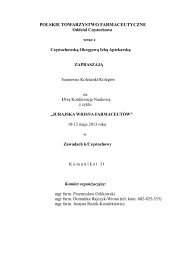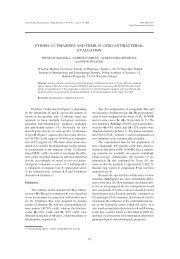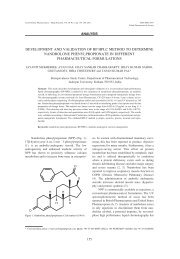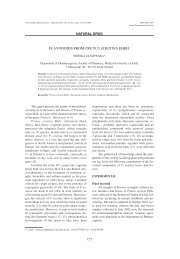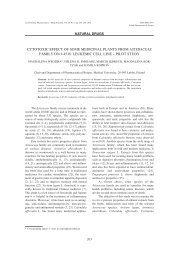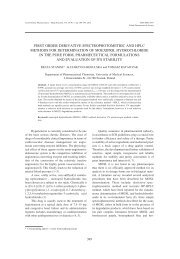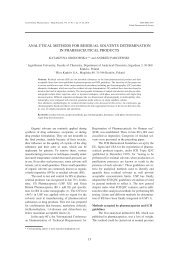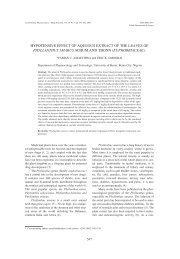phytochemical and antimicrobial screening of methanol and ...
phytochemical and antimicrobial screening of methanol and ...
phytochemical and antimicrobial screening of methanol and ...
Create successful ePaper yourself
Turn your PDF publications into a flip-book with our unique Google optimized e-Paper software.
Acta Poloniae Pharmaceutica ñ Drug Research, Vol. 68 No. 4 pp. 535ñ539, 2011 ISSN 0001-6837<br />
Polish Pharmaceutical Society<br />
NATURAL DRUGS<br />
PHYTOCHEMICAL AND ANTIMICROBIAL SCREENING OF METHANOL<br />
AND AQUEOUS EXTRACTS OF AGAVE SISALANA<br />
CHRINIUS HAMMUEL 1 , GARY G. YEBPELLA 2 , GIDEON A. SHALLANGWA 3 *, ASABE M.<br />
MAGOMYA 2 <strong>and</strong> ABEL S. AGBAJI 2<br />
1<br />
Environmental Services Division, National Research Institute for Chemical Technology, Zaria-Nigeria<br />
2<br />
Industrial Chemical Division, National Research Institute for Chemical Technology, Zaria-Nigeria<br />
3<br />
Chemistry Department,Ahmadu Bello University, Samaru Campus, Zaria-Nigeria<br />
Abstract: The <strong>methanol</strong> <strong>and</strong> the aqueous extracts <strong>of</strong> the plant, Agave sisalana were prepared <strong>and</strong> evaluated for<br />
its <strong>phytochemical</strong> properties <strong>and</strong> <strong>antimicrobial</strong> activities. The <strong>phytochemical</strong> analysis <strong>of</strong> the preparation revealed<br />
the presence <strong>of</strong> some secondary metabolites which include: saponins, glycosides, cardiac glycosides, steroids,<br />
tannins <strong>and</strong> flavonoids. The in vitro <strong>antimicrobial</strong> activity <strong>of</strong> the crude <strong>methanol</strong> <strong>and</strong> aqueous extract <strong>of</strong> the Agave<br />
sisalana were investigated. The extract showed <strong>antimicrobial</strong> activities against the test organisms with different<br />
zones <strong>of</strong> inhibition ranging from 28ñ32 mm <strong>and</strong> 25ñ29 mm for <strong>methanol</strong> <strong>and</strong> aqueous extract, respectively. The<br />
minimum inhibitory concentration (MIC) <strong>of</strong> both the <strong>methanol</strong> <strong>and</strong> aqueous extract was between 10ñ20 mg/mL,<br />
<strong>and</strong> the minimum bactericidal concentration (MBC) was between 20ñ40 mg/mL for both extracts. The investigation<br />
indicated that the <strong>methanol</strong> extract inhibited the growth <strong>of</strong> the microbes more than the aqueous extract.<br />
The ability <strong>of</strong> the crude extracts <strong>of</strong> A. sisalana to inhibit the growth <strong>of</strong> the microbes is an indication <strong>of</strong> its <strong>antimicrobial</strong><br />
potential, which may be employed in the management <strong>of</strong> microbial infections.<br />
Keywords: Agave sisalana, <strong>antimicrobial</strong> activity, <strong>phytochemical</strong> properties, minimum inhibitory concentration,<br />
minimum bactericidal concentration<br />
In history, plants have played a major role in<br />
the production <strong>of</strong> biological compounds for the formation<br />
<strong>of</strong> drugs. Their role may either become a<br />
base for the development <strong>of</strong> medicine, a natural blue<br />
print for the development <strong>of</strong> new drugs or a phytomedicine<br />
to be used for the treatment <strong>of</strong> diseases<br />
(1). Even the World Health Organization (WHO)<br />
supports the use <strong>of</strong> medicinal plants, provided it is<br />
proven to be efficacious <strong>and</strong> safe (2). The scientific<br />
search for new drugs from natural products remains<br />
a serious task for scientists worldwide. It is a fact<br />
that a large segment <strong>of</strong> the population in tropical<br />
countries rely on traditional medicines for their<br />
health needs (3). Over 80% <strong>of</strong> population in the<br />
developing world make use <strong>of</strong> medicinal plants<br />
extracts to provide health (4). The searches for new<br />
compounds with <strong>antimicrobial</strong> activity from plants<br />
have been the subject for intense research in recent<br />
years (5ñ7). This is due to the fact that plant are<br />
widely used in folk medicine to combat various diseases<br />
in human caused by pathogenic organisms<br />
(8ñ10). For this reason, many researchers are aiming<br />
to scientifically prove the use <strong>of</strong> plant extracts as an<br />
effective means <strong>of</strong> control <strong>of</strong> infections <strong>and</strong> body<br />
malfunctions (11, 12).<br />
Agave sisalana, popularly known as sisal,<br />
belongs to a family known as Agavaceae. It is a<br />
monocotelydenous plant from Mexico, it spreads to<br />
semi-arid regions. Today, Brazil is the largest production<br />
<strong>of</strong> sisal for the supply <strong>of</strong> fibers (13). In the<br />
19th century, the plant spreaded to countries in<br />
Africa like Tanzania <strong>and</strong> Kenya <strong>and</strong> Asian countries.<br />
Today it has covered some parts the tropics. A.<br />
sisalana is used as a rope. It has also been used for<br />
making cloths, wall coverings <strong>and</strong> carpets (14). It<br />
contains saponins, which can be found in excess in<br />
the leaves <strong>and</strong> can be used in the production <strong>of</strong> soap<br />
(15). It is used in l<strong>and</strong> reclamation schemes in arid<br />
regions <strong>of</strong> the world (16). The dried flowering stems<br />
are used as waterpro<strong>of</strong> thatch (15). In some parts <strong>of</strong><br />
the northern Nigeria, the flowering stems are also<br />
used as quiver for arrows. It has also been reported<br />
that the plant has insecticidal properties; however,<br />
further details are not yet given (17). The heart <strong>of</strong><br />
* Corresponding author: e-mail: gashallangwa@gmail.com; phone: +234802390<br />
535
536 CHRINIUS HAMMUEL et al.<br />
the plant is very rich in saccharine matter <strong>and</strong> can be<br />
eaten when baked (18). The seed ground into flour is<br />
used as a thickener in soups or used with cereal<br />
flours when making bread (19).<br />
Medically, it has also been reported that the<br />
plant is useful in the treatment <strong>of</strong> some infectious<br />
diseases <strong>and</strong> body malfunctions. The sap is used in<br />
the manufacture <strong>of</strong> gum arabic (binding agent) <strong>and</strong><br />
resins for pharmaceutical industries (16). The sap<br />
can also be taken internally for the treatment <strong>of</strong> diarrhea,<br />
dysentery, etc. (20). The gum from the root is<br />
used in the treatment <strong>of</strong> toothache <strong>and</strong> the root itself<br />
is diuretic <strong>and</strong> diaphoretic, it is also used in the treatment<br />
<strong>of</strong> syphilis, local inflammation <strong>and</strong> tumor (17).<br />
The plant is used internally in the treatment <strong>of</strong> indigestion,<br />
flatulence, constipation <strong>and</strong> jaundice (16).<br />
In this work, the <strong>antimicrobial</strong> property <strong>of</strong> the<br />
plant leave extracts against some strains <strong>of</strong> microorganisms<br />
was evaluated. Thus, the <strong>phytochemical</strong><br />
with adequate <strong>antimicrobial</strong> efficacy proved that the<br />
plant may be adapted for treatment <strong>of</strong> some infections<br />
caused by microorganisms.<br />
MATERIALS AND METHODS<br />
Preparation <strong>of</strong> extracts<br />
Fresh leaves <strong>of</strong> the plant were collected at the<br />
National Research Institute for Chemical<br />
Technology (NARICT), Zaria <strong>and</strong> was identified by<br />
the Department <strong>of</strong> Botany, Faculty <strong>of</strong> Sciences,<br />
Ahmadu Bello University, Zaria, Kaduna state <strong>of</strong><br />
Nigeria.<br />
The leave was dried at 50 O C using electric drier<br />
<strong>and</strong> crushed with the aid <strong>of</strong> a mechanical grinder to<br />
powdered form. This powdered plant material<br />
(250 g) was weighed <strong>and</strong> transferred into 400 mL <strong>of</strong><br />
water <strong>and</strong> <strong>methanol</strong>, respectively. The crushed plant<br />
material was allowed to soak for two days with<br />
shaking at intervals <strong>of</strong> time to ensure proper extraction<br />
<strong>of</strong> the active ingredients from the sample<br />
according to the method reported by Harborne (21).<br />
The mixtures were then filtered on Whatmanís No.1<br />
filter paper. The <strong>methanol</strong> filterate was concentrated<br />
to dryness using rotary evaporator in vacuo to obtain<br />
the crude <strong>methanol</strong> extract. The aqueous extract was<br />
lyophilized to obtain a dry powder extract. The<br />
respective extracts obtained were kept in a refrigerator<br />
until use.<br />
Test microorganisms<br />
The test microorganisms employed for these<br />
studies include two Gram positive bacteria<br />
(Staphylococcus aureus <strong>and</strong> Streptococcus pyogenes),<br />
two Gram negative bacteria (Escherichia<br />
coli <strong>and</strong> Salmonella typhi) <strong>and</strong> one fungus (C<strong>and</strong>ida<br />
albicans). The clinical isolates were all obtained<br />
from the Department <strong>of</strong> Medical Microbiology,<br />
Ahmadu Bello University Teaching Hospital, Zaria,<br />
Nigeria.<br />
Phytochemical <strong>screening</strong> <strong>of</strong> plant extracts<br />
The extracts were subjected to tests for secondary<br />
metabolites such as tannins, flavonoids,<br />
steroids, glycosides, cardiac glycosides <strong>and</strong><br />
saponins. The tests were carried out using st<strong>and</strong>ard<br />
methods <strong>of</strong> analysis (3, 22).<br />
Antimicrobial <strong>screening</strong>.<br />
The <strong>antimicrobial</strong> activity <strong>of</strong> the plant extracts<br />
were determined using agar well diffusion method<br />
(23ñ25). The bacterial <strong>and</strong> the fungal isolates collected<br />
in prepared slants <strong>of</strong> nutrients agar were subcultured<br />
into prepared nutrients broth <strong>and</strong> incubated<br />
at 37 O C for 24 h <strong>and</strong> st<strong>and</strong>ardized to 0.5 Mc-Farl<strong>and</strong><br />
Scale (10 8 cfu/mL) in a prepared normal saline. The<br />
cell suspensions were seeded into prepared plates <strong>of</strong><br />
nutrients agar. Wells were then bored into the plates<br />
<strong>of</strong> the seeded organism using sterile cork-borer <strong>of</strong> 6<br />
mm in diameter. Each <strong>of</strong> the <strong>methanol</strong> <strong>and</strong> aqueous<br />
concentrated extracts (0.4 g) were constituted into<br />
10 mL <strong>of</strong> their respective solvents <strong>of</strong> extraction<br />
(<strong>methanol</strong> <strong>and</strong> water), making the initial concentration<br />
to be 40 mg/mL. The concentrations were introduced<br />
to fill the wells created to the bream <strong>and</strong><br />
allowed to st<strong>and</strong> for 30 min at room temperature for<br />
proper diffusion <strong>and</strong> then incubated at 37 O C for 24 h<br />
in an incubator. Controls were also set up in parallel,<br />
but using the solvents <strong>of</strong> extractions only. After<br />
the 24 h incubation, the plates were observed for<br />
zones <strong>of</strong> inhibition which were recorded in millimeters<br />
(mm).<br />
Minimum inhibitory concentration (MIC)<br />
The determination <strong>of</strong> the MIC <strong>of</strong> the crude<br />
extracts was carried out using the test tube dilution<br />
methods (26ñ28). Each <strong>of</strong> the extracts was constituted<br />
by dissolving 0.4 g <strong>of</strong> the concentrates in 10<br />
mL <strong>of</strong> nutrient broth, making the concentration to be<br />
40 mg/mL. Five tubes <strong>of</strong> 5 mL <strong>of</strong> nutrient broth<br />
were set up, <strong>and</strong> 5 mL <strong>of</strong> the 40 mg/mL <strong>of</strong> the<br />
extracts were taken <strong>and</strong> used for two-fold dilution<br />
into the five tubes <strong>of</strong> the nutrient broth, making the<br />
concentration to be 40 mg/mL, 20 mg/mL, 10<br />
mg/mL, 5 mg/mL <strong>and</strong> 2.5 mg/mL. Normal saline<br />
was used to prepare a turbid suspension <strong>of</strong> the<br />
microbes, the dilution <strong>of</strong> the microorganism was<br />
done continuously in the normal saline until the turbidity<br />
marched that <strong>of</strong> 0.5 Mc-Farl<strong>and</strong>ís st<strong>and</strong>ard by
Phytochemical <strong>and</strong> <strong>antimicrobial</strong> <strong>screening</strong> <strong>of</strong> <strong>methanol</strong> <strong>and</strong>... 537<br />
visual comparison. At that point, microorganism has<br />
concentration <strong>of</strong> about 1.5◊10 8 cfu/mL. One drop<br />
equivalent to 0.1 mL <strong>of</strong> the suspension <strong>of</strong> the<br />
microbes (prepared as previously described) was<br />
transferred into the different test tubes. The tubes<br />
were incubated at 37 O C for 24 h. The minimum<br />
inhibitory concentration was regarded as the lowest<br />
concentration that inhibited visible growth.<br />
Minimum bactericidal concentration (MBC)<br />
The minimum bactericidal concentration<br />
(MBC) <strong>of</strong> the plant extracts was determined by<br />
using the method <strong>of</strong> Spencer <strong>and</strong> Spencer (29). The<br />
tubes <strong>of</strong> the MIC that showed no growth (no turbidity)<br />
<strong>of</strong> the microbes were sub-cultured into a freshly<br />
prepared nutrient agar plates <strong>and</strong> incubated at 37 O C<br />
for 24 h. The MBC was taken as the concentration<br />
<strong>of</strong> the extract that did not show any colony growth<br />
on the new set <strong>of</strong> the agar plates.<br />
RESULTS AND DISCUSSION<br />
Phytochemical <strong>screening</strong><br />
The <strong>phytochemical</strong> analysis (Table 1) showed<br />
that the concentration <strong>of</strong> saponins were high (+++)<br />
in the aqueous extract while the same were moderate<br />
(++) in the <strong>methanol</strong> extract. Steroids, tannins<br />
<strong>and</strong> flavonoids were all moderately present (++) in<br />
the <strong>methanol</strong> extract, whereas in the aqueous extract<br />
only flavonoids were <strong>of</strong> moderate concentration,<br />
with steroids <strong>and</strong> tannins <strong>of</strong> low concentrations (+).<br />
Cardiac glycosides were low in concentration in the<br />
<strong>methanol</strong>ic extract (+) <strong>and</strong> absent in aqueous<br />
extract.<br />
These compounds are found to be biologically<br />
active <strong>and</strong> therefore, aid in the <strong>antimicrobial</strong> activities.<br />
These secondary metabolites exert <strong>antimicrobial</strong><br />
activity by different mechanisms; tannins has<br />
been found to react with proline-rich protein to from<br />
irreversible complexes (30), resulting in the inhibition<br />
<strong>of</strong> cell protein synthesis. Herbs that have tannins<br />
as their major components are astringent in<br />
nature <strong>and</strong> are used for treating intestinal disorders<br />
such as diarrhea <strong>and</strong> dysentery (31). Therefore,<br />
these observations could support the use <strong>of</strong> this plant<br />
in herbal cure remedies. The presence <strong>of</strong> saponins<br />
lend credence to the use <strong>of</strong> this plant in managing<br />
inflammation (32) worked on steroidal extracts from<br />
medical plants which exhibited antibacterial activities<br />
on some bacterial isolates. Flavonoids have also<br />
exhibited a wide range <strong>of</strong> biological activities; such<br />
as <strong>antimicrobial</strong>, antioxidant, anti-inflammatory,<br />
analgesic, anti-allergic <strong>and</strong> cytostatic properties<br />
(33).<br />
Antimicrobial activity<br />
Both the <strong>methanol</strong> <strong>and</strong> aqueous extracts<br />
showed varying degree <strong>of</strong> <strong>antimicrobial</strong> activity<br />
against the test organisms (Table 2). The <strong>methanol</strong><br />
extract (inhibition zone 28ñ32 mm) was found to be<br />
more effective than the aqueous extract (inhibition<br />
zone 25ñ29 mm) against all the test organisms. In<br />
<strong>methanol</strong> extract, Escherichia coli was more susceptible<br />
than any other selected organism with zone <strong>of</strong><br />
inhibition <strong>of</strong> 32 mm <strong>and</strong> Salmonella typhi showed<br />
the least susceptibility. Also for the aqueous extract,<br />
Staphylococcus aureus was highly susceptible to the<br />
extract (29 mm) <strong>and</strong> Streptococcus pyogenes<br />
showed the least susceptibility (25 mm).<br />
Minimum inhibitory concentration (MIC) <strong>and</strong><br />
minimum bactericidal concentration (MBC) evaluations<br />
The minimum inhibitory concentration (MIC)<br />
<strong>of</strong> both the <strong>methanol</strong> <strong>and</strong> aqueous extract against the<br />
different test organism ranged from 10ñ20 mg/mL<br />
(Table 3). The MIC <strong>of</strong> both the extracts against<br />
Staphylococcus aureus, C<strong>and</strong>ida albicans, Escherichia<br />
coli <strong>and</strong> Streptococcus pyogenes start from 10<br />
mg/mL; Salmonella typhi was inhibited by the two<br />
extracts at 20 mg/mL. Also at this concentration<br />
Table1. The <strong>phytochemical</strong> components <strong>of</strong> the extracts.<br />
Methanol Aqueous<br />
extract extract<br />
Saponnins ++ +++<br />
Steroids ++ +<br />
Tannins ++ +<br />
Flavonoids ++ ++<br />
Cardiac<br />
glycosides1 + ñ<br />
+++ = high concentration; ++ = moderate concentration;<br />
+ = low concentration; ñ = absent<br />
Table 2. The <strong>antimicrobial</strong> activity <strong>of</strong> the extracts showing zones<br />
<strong>of</strong> inhibition (mm)<br />
Test organism Methanol Aqueous<br />
extract extract<br />
Staphylococcus aureus 30 29<br />
Salmonella typhi 28 27<br />
Escherichia coli 32 26<br />
Streptococcus pyogenes 30 25<br />
C<strong>and</strong>ida albicans 31 28
538 CHRINIUS HAMMUEL et al.<br />
Table 3. Minimum inhibitory concentration <strong>of</strong> the extracts against the microbes.<br />
Test organism<br />
Methanol extract [mg/mL]<br />
Aqueous extract [mg/mL]<br />
40 20 10 5 2.5 40 20 10 5 2.5<br />
Staphylococcus<br />
aureus ñ ñ 0* + ++ ñ ñ 0* + ++<br />
Salmonella<br />
typhi ñ 0* + ++ +++ ñ 0* + ++ +++<br />
Escherichia<br />
coli ñ ñ 0* + ++ ñ 0* + ++ +++<br />
Streptococcus<br />
pyogenes ñ ñ 0* + ++ ñ 0* ñ + ++<br />
C<strong>and</strong>ida<br />
albicans ñ ñ 0* + ++ ñ ñ 0* ++ +++<br />
ñ = no growth; 0* = MIC + = light growth; ++ = moderate growth; +++ = high growth<br />
Table 4. Minimum bactericidal concentration (MBC) <strong>of</strong> the extracts against the microbes.<br />
Test organism<br />
Methanol extract [mg/mL]<br />
Aqueous extract [mg/mL]<br />
40 20 10 5 2.5 40 20 10 5 2.5<br />
Staphylococcus<br />
aureus ñ 0 + ++ ñ 0 + ++ +++<br />
Salmonella<br />
typhi 0 + ++ +++ 0 + ++ +++ +++<br />
Escherichia<br />
coli ñ 0 + ++ 0 + ++ +++ +++<br />
Streptococcus<br />
pyogenes ñ 0 + ++ 0 + ++ +++ +++<br />
C<strong>and</strong>ida<br />
albicans ñ 0 + ++ ñ 0 + ++ +++<br />
ñ = no growth; 0* = MIC + = light growth; ++ = moderate growth; +++ = high growth<br />
Escherichia coli <strong>and</strong> S. pyogenes were inhibited by<br />
the aqueous extract.<br />
The minimum bactericidal concentration<br />
(MBC) <strong>of</strong> both extracts against the different organism<br />
ranged between 20ñ40 mg/mL (Table 4). The<br />
MBC <strong>of</strong> both the extracts starts from 20 mg/mL<br />
against Staphylococcus aureus <strong>and</strong> C<strong>and</strong>ida albicans.<br />
Then the MBC <strong>of</strong> <strong>methanol</strong> extract against<br />
Escherichia coli <strong>and</strong> S. pyogenes also starts from 20<br />
mg/mL. At concentration <strong>of</strong> 40 mg/mL, Salmonella<br />
typhi were killed by both extracts <strong>and</strong> E. coli <strong>and</strong> S.<br />
pyogenes were also killed by the aqueous extract.<br />
CONCLUSION<br />
The extracts <strong>of</strong> A. sisalana has demonstrated<br />
significant biological activity against the test pathogenic<br />
organisms <strong>and</strong> this has introduced the plant as<br />
a potential c<strong>and</strong>idate for drug development for the<br />
treatment <strong>of</strong> diseases caused by these pathogens<br />
(34). Of course, there would be the need to ascertain<br />
by further studies whether any single or combination<br />
<strong>of</strong> the pure active metabolites (35) would be better,<br />
safer <strong>and</strong> more efficient in treating diseases caused<br />
by the selected pathogens than the whole plant<br />
(crude extracts) or not.<br />
REFERENCES<br />
1. Iwu M.: H<strong>and</strong>book <strong>of</strong> African Medical Plants.<br />
pp. 27ñ44, CRC Press, Boca Raton, FL. 1993.<br />
2. World Health Organization (WHO): The World<br />
Health Report. Bridging the gap. 1, p. 118,<br />
WHO, Geneva 1995.<br />
3. S<strong>of</strong>owara, A.: Screening Plants for Bioactive<br />
Agents. In: Medicinal Plants <strong>and</strong> Traditional<br />
Medicine in Africa. 2 nd ed., pp. 42ñ44, 221ñ229,<br />
246ñ249, 304ñ306, 331ñ332, 391ñ393,<br />
Spectrum Books Ltd., Sunshine House, Ibadan,<br />
Nigeria 1993.
Phytochemical <strong>and</strong> <strong>antimicrobial</strong> <strong>screening</strong> <strong>of</strong> <strong>methanol</strong> <strong>and</strong>... 539<br />
4. World Health Organization (WHO): Traditional<br />
medicine. Growing needs <strong>and</strong> potential, WHO<br />
policy Perspectives on Medicines, pp.1ñ6,<br />
WHO, Geneva 2002.<br />
5. Harvey A.L.: Curr. Opin. Chem. Biol. 11, 480<br />
(2007).<br />
6. Lee S.H., Chang K.S., Su M.S., Huang Y.S.,<br />
Jang H.D.: Food Control 18, 1547 (2007).<br />
7. Hostettmann K., Queiroz E.F., Viera P.C.:<br />
Pricipios activos de plantas superiores,<br />
EdUFSCarlos, S„o Carlos, 2003.<br />
8. Stefanello M.E.A., Salvador M.J., Ito I.Y.,<br />
Macani P.A.T.: Rev. Braz. Farmacogn. 16, 525<br />
(2004).<br />
9. Duarte M.C.T., Figueira G.M., Pereira B.,<br />
Magalhaes P.M., Delarmelina C.: Rev. Bras.<br />
Pharmacogn. 14, 6 (2004).<br />
10. Cruz M.C.S., Sautos P.O., Barbosa Jr A.M.,<br />
Melo D.L.F.M., Alviano C.S., Antoniolli A.R.,<br />
Alviano D.S., Trindade R.C.: J.<br />
Enthnopharmacol. 111, 409 (2007).<br />
11. Weckesser S., Engel K., Simon-Haarhaus B.,<br />
Wittmer A., Pelz K., Schempp C.M.: J.<br />
Phytomedicine 14, 508 (2007)<br />
12. More G., Tsikalange T.E., Lall N., Botha F.,<br />
Meyer J.J.M.: J. Ethnopharmacol. 119, 473<br />
(2008).<br />
13. Oashi M.C.G.: PhD thesis Federal University <strong>of</strong><br />
Santa Catarina, Brazil, 1999.<br />
14. Kadoph S.J., Aun L. L<strong>and</strong>ford: Textiles. 9 edn.,<br />
Pearson Education Inc., New Jersey 2002.<br />
15. Hedrick U.P.: Sturtevantís Edible Plants <strong>of</strong> the<br />
World, Dover Publication, Dover 1972.<br />
16. Bown D.: Encyclopedia <strong>of</strong> herbs <strong>and</strong> their uses.<br />
Dorlings Kindersley, London 1995.<br />
17. Duke J.A., Ayensu E.S.: Medicinal plants <strong>of</strong><br />
China. Reference Publications Inc., Algonac MI<br />
1985.<br />
18. Facciola S.: Cornucopia ñA source book <strong>of</strong> edible<br />
plants. Kampong Publications. Kampong<br />
1990.<br />
19. Balls E.K.: Early uses <strong>of</strong> California plants.<br />
University <strong>of</strong> California Press, Berkeley, CA<br />
1975.<br />
20. Chevellier, A.: The Encyclopedia <strong>of</strong> Medicinal<br />
Plants. Dorlings Kindersley, London 1996.<br />
21. Harborne J.B.: Phytochemical methods ñ A<br />
guide to modern techniques <strong>of</strong> plant analysis.<br />
pp. 182ñ190, Chapman <strong>and</strong> Hall, London 1998.<br />
22. Trease G.E, Evans W.C.: Phytochemical<br />
Screening <strong>and</strong> In vitro Bioactivity <strong>of</strong><br />
Cnidoscolus, 15 th ed., pp. 211ñ214, 241ñ242,<br />
WB Saunders, Edinburgh 2002.<br />
23. Irobi O.N., Moo-Young M., Anderson W.A.: J.<br />
Pharm. 34, 87 (1996).<br />
24. Ver P., LeGr<strong>and</strong> B., Wondergem A., Pousset<br />
J.L.: J. Ethnopharmacol. 22, 25 (1988).<br />
25. Russel A.D., Furr J.R.: J. Appl. Bacteriol. 43,<br />
253 (1977).<br />
26. Akinpelu D.A., Kolawale D.O.: Sci. focus J. 7,<br />
64 (2004).<br />
27. Barry A.L, ThornsBerry C.: J. Clin. Pathol. 19,<br />
492 (1985).<br />
28. Cruickshank R., Duguid J.P., Marmion B.P.,<br />
Swain R.H.A.: Test for sensitivity to <strong>antimicrobial</strong><br />
agents. in Medical Microbiology, 12 th edn.,<br />
Vol. 2, p. 190, Churchill Livingstone, Edinburgh<br />
1975.<br />
29. Spencer A.L.R., Spencer J.F.T.: Public Health<br />
Microbiology: Methods <strong>and</strong> protocols. pp. 325-<br />
332, Humana Press Inc. New Jersey, 2004.<br />
30. Shimada T.: J. Chem. Ecol. 32, 1149 (2006).<br />
31. Dharman<strong>and</strong>a S.: Gall nuts <strong>and</strong> the uses <strong>of</strong> tannins<br />
in Chinese medicine. In: Proceedings <strong>of</strong><br />
Institute for Traditional Medicine, Portl<strong>and</strong>,<br />
Oregon 2003.<br />
32. Quinlan M.B., Quinlan R.J., Nolan J.M.: J.<br />
Ethnopharmacol. 80, 75 (2000).<br />
33. Hodek P., Irefil P., Stiborova M.: Chem. Biol.<br />
Interact. 139, 1 (2002).<br />
34. Igbinosa O.O., Igbinosa E.O., Aiyegoro O.A.:<br />
Afr. J. Pharm. Pharmacol. 3, 58 (2009).<br />
35. Shariff Z.U.: Modern Herbal Therapy for<br />
Common Ailments. Nature Pharmacy Series,<br />
Vol. 1, p. 9, Spectrum Books Ltd., Ibadan,<br />
Nigeria in association with Safari Books<br />
(Export) Ltd., UK 2001.<br />
Received: 17. 05. 2010



